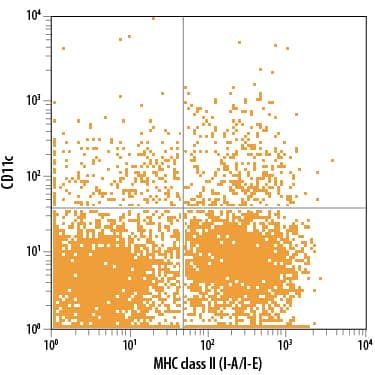Human Occludin Antibody Summary
Accession # Q16625
Customers also Viewed
Applications
Please Note: Optimal dilutions should be determined by each laboratory for each application. General Protocols are available in the Technical Information section on our website.
Scientific Data
 View Larger
View Larger
Occludin in HUVEC Human Cells. Occludin was detected in immersion fixed HUVEC human umbilical vein endothelial cells using Mouse Anti-Human Occludin Monoclonal Antibody (Catalog # MAB7074) at 10 µg/mL for 3 hours at room temperature. Cells were stained using the Northern-Lights™ 557-conjugated Anti-Mouse IgG Secondary Antibody (red; Catalog # NL007) and counterstained with DAPI (blue). Specific staining was localized to cytoplasm. View our protocol for Fluorescent ICC Staining of Cells on Coverslips.
 View Larger
View Larger
Detection of Human Occludin by Western Blot Analysis of barrier formation in endothelial monolayer.(A) Expression of endothelial junctional molecules CD31, CD144 and ZO-1 (from left to right) and actin (far right) in hCMVEC monolayer 48 h after seeding. (B) The permeability of hCMVEC monolayer to FITC-dextran 48 h after seeding (mean ± SEM, n = 4). (C) Time course analysis of endothelial tight junction molecule occludin expression at 24, 48 and 72 h post seeding of hCMVECs using Western blot using a mouse monoclonal anti-occludin (left) and rabbit polyclonal anti-occludin (right). (D) Real time measurement of electrical resistance across the endothelial monolayer as an indicator of endothelial barrier integrity. The barrier resistance (Rb) and the basolateral adhesion (Alpha) due to focal adhesions can be modelled using the ECIS Z theta software when the experiment is run using multi-frequency mode (250 to 64000 Hz). The modelling reveals that the basolateral adhesion occurs very fast and junction formation begins around 10 hours after seeding. Overall barrier resistance is the summation of both Rb and alpha, but this software function can determine whether barrier changes are predominantly due to the Rb. Data are mean ± SEM (n = 4). Image collected and cropped by CiteAb from the following publication (https://dx.plos.org/10.1371/journal.pone.0180267), licensed under a CC-BY license. Not internally tested by R&D Systems.
Preparation and Storage
- 12 months from date of receipt, -20 to -70 °C as supplied.
- 1 month, 2 to 8 °C under sterile conditions after reconstitution.
- 6 months, -20 to -70 °C under sterile conditions after reconstitution.
Background: Occludin
Occludin is an integral membrane protein with an apparent molecular mass of approximately 65 kDa. It is localized exclusively at tight junctions (TJ) of select epithelial and endothelial cells. The protein is 522 amino acids (aa) in length and contains a cytoplasmic N-terminus, four transmembrane domains, and a long COOH‑terminal cytoplasmic domain (domain E) that contains 255 aa. Residues 1-66 make up the first cytoplasmic domain, and that is included in the MARVEL region consisting of aa 57-210. The MARVEL region is a membrane-associating domain that spans aa 67-243. Of note, residues 92-131 are glycine and tyrosine rich. Residues 244-265 constitute the last transmembrane region, with aa 266-522 representing the long cytoplasmic domain termed domain E. At the TJ, Occludin associates with membrane peripheral protein ZO-1 (220 kDa). Human Occludin shares 90% aa sequence identity with mouse Occludin.
Product Datasheets
Citations for Human Occludin Antibody
R&D Systems personnel manually curate a database that contains references using R&D Systems products. The data collected includes not only links to publications in PubMed, but also provides information about sample types, species, and experimental conditions.
2
Citations: Showing 1 - 2
Filter your results:
Filter by:
-
IL-13 Impairs Tight Junctions in Airway Epithelia
Authors: H Schmidt, P Braubach, C Schilpp, R Lochbaum, K Neuland, K Thompson, D Jonigk, M Frick, P Dietl, OH Wittekindt
Int J Mol Sci, 2019-06-30;20(13):.
Species: Human
Sample Types: Whole Cells
Applications: ICC -
ECIS technology reveals that monocytes isolated by CD14+ve selection mediate greater loss of BBB integrity than untouched monocytes, which occurs to a greater extent with IL-1 beta activated endothelium in comparison to TNF alpha
Authors: Dan Ting Kho, Rebecca Johnson, Laverne Robilliard, Elyce du Mez, Julie McIntosh, Simon J. O’Carroll et al.
PLOS ONE
FAQs
No product specific FAQs exist for this product, however you may
View all Antibody FAQsIsotype Controls
Reconstitution Buffers
Secondary Antibodies
Reviews for Human Occludin Antibody
There are currently no reviews for this product. Be the first to review Human Occludin Antibody and earn rewards!
Have you used Human Occludin Antibody?
Submit a review and receive an Amazon gift card.
$25/€18/£15/$25CAN/¥75 Yuan/¥2500 Yen for a review with an image
$10/€7/£6/$10 CAD/¥70 Yuan/¥1110 Yen for a review without an image






















